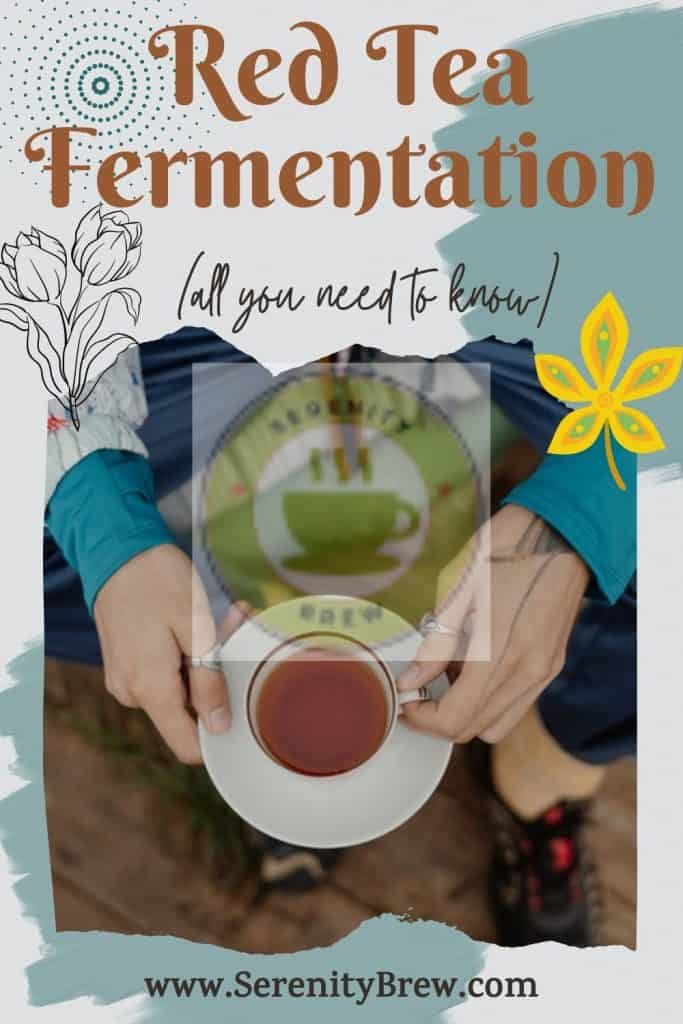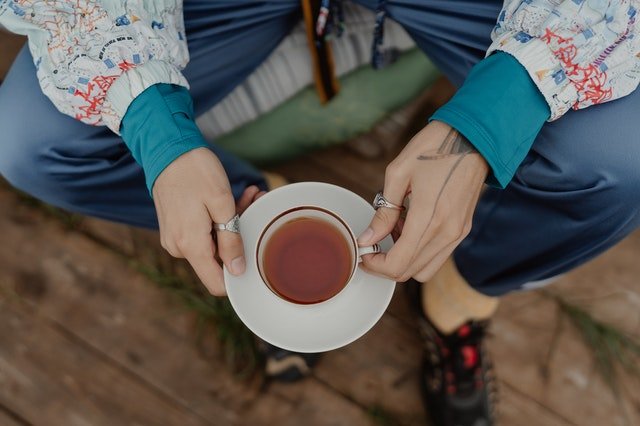
Red tea is the only type of tea that undergoes true microbial fermentation and not oxidation like black or oolong teas. The main characteristic and what makes it so special is that it is a fermented tea. But what does it mean that it is a fermented tea?
All teas come from the same tree: Camellia Sinensis, but not all teas are the same. Surely you know or have heard of white tea, green tea, black tea and the famous red tea. But what if they all come out of the same tree? Because they are different.
Well, because they are processed differently. Green and white teas do not undergo any oxidation or fermentation. Black teas are oxidized and red teas are fermented.
This article is going to explain to you how this microbial fermentation occurs and what consequences it produces in the tea with the intention that you can value this fantastic tea with more knowledge.
Well, let’s go! and we start.
The raw material of red tea
The raw material for red tea is the leaves from old trees.
These trees come from a variety known as “broad tea leaf” (??, dà yè) found in southwestern China and in the border regions of Burma, Vietnam, and Laos.
The leaves are covered with fine hairs and are larger than other tea leaves, as well as having a different chemical composition. The leaves of the trees often grow wild in what are called “tea hills” and are often very valuable; Sometimes connoisseurs of puerh seek out leaves taken from the wild forests of just one “tea mountain,” not mixed with leaves from any other area.
Two subtle differences worth noting are that puerh is not produced from the Chinese small leaf varietal, but the broad leaf varietal is mostly found in the southern provinces of China and India.
The second is that puerh leaves are picked as a shoot and 3-4 leaves, while green tea is picked as a shoot and 1-3 leaves. This means that the older leaves contribute to the qualities of puerh tea.
Maocha green tea
Puerh is typically made through two steps.
The first step is to obtain Maocha green tea (literally “rough green tea” or rough tea). The processing is minimal and it does not undergo any fermentation. What is intended at this stage is to dry the leaves and prevent them from spoiling.
The first thing to do is to collect the appropriate young leaves. The torn leaves are carefully handled to avoid breakage and unwanted oxidation. Optionally and depending on the producer, the leaves are allowed to wither to facilitate the rolling of the leaves .
Drying is done in several stages, formerly the leaves were spread out in the sun or in a ventilated space to wither and remove part of the water content. On cloudy or rainy days the leaves wither through heating. Subsequently, the green is “killed”, that is, it is dry roasted in large woks with the double objectives of:
Deactivate enzymes and prevent oxidation of green leaves
Dehydrate the product preventing enzymatic reactions from taking place.
The difference with the green tea produced in China is that it is not dried with hot air after the cooking phase, which leaves a small amount of enzymes that contribute to a small oxidation during drying in the sun, contributing to give the unique characteristics of Pu Erh.
Elaboration of Ripe Pu Erh, cooked or Shu Cha
A technique called Wò Dui is used, which consists of stacking, moistening and turning the Maocha green tea in a way very similar to composting.
What this technique does is transform Maocha green tea into Pu erh in an accelerated way by controlling the humidity, temperature and oxygenation conditions during the bacterial and fungal fermentation that occurs.
This process of stacking the leaves, moisturizing and mixing the máochá ensures a uniform fermentation that usually lasts between 45-60 days, obtaining a product similar to Pu Erh Crudo or Sehng Cha aged 15 or 30 years.
The cultures and strains that are generated and cause fermentation vary in every factory in Yunnan but are known to be strains of Aspergillus spp., Penicillium spp. , and Yeasts.
The control of humidity and the growth of Aspergillus spp., is the key to the production of high quality Pu Erh. Poor control during the fermentation/oxidation process can lead to poor Pu Erh with decomposed leaves and a compost-like aroma and texture.
Everyone assures that no additives are added to this fermentation, but we do not know anyone who has been able to visit the fermentation warehouses in Yunnan, it seems that the most they teach you are the classification, packaging and storage rooms.
It can be consumed without undergoing any additional loose or pressed aging or it can be stored for a time with the intention of eliminating some undesirable odors and aromas during fermentation.
Pu Erh Crudo o Sehng Cha
It is the traditional Pu Erh and the one that was performed before 1973. From the Maocha green tea, a pressing, a microbial fermentation and the final packaging are carried out.
Pressing
To produce the pressed Pu Erh, a preparation process is carried out before carrying out the pressing itself.
In the first place, the exact amount of te maocha necessary to obtain the final weight of the Pu Erh is determined, depending on the final form in which the Pu Erh is to be presented.
Subsequently, it is slightly humidified with water vapor to soften it and make it more “gummy”, which allows it to be kept compact and does not crumble during pressing.
It is inserted into perforated cans and sometimes a ticket ( nèi fei) or decorations such as ribbons are added to the middle or top of the leaves.
It is then inverted in a cloth bag and twisted into a ball. Von the extra cloth a tie is made forming a knot that is what produces the typical indentation on the back of the pressed Pu Erh. In the Pu erh in the form of a brick or square, rolled cloths are not used.
Nowadays, hydraulic presses with molds are used to decorate the Pu Erh with reliefs. Formerly manual presses were used that consisted of a heavy stone carved in the shape of a short cylinder with a handle.
Subsequently, the cloth bag is removed and placed on shelves to let it dry in the air for weeks or months depending on the resulting humidity after pressing.
Fermentation of Raw Pu Erh or Sehng Cha.
Pu ehr undergoes what is known as a solid-state fermentation where the water activity is low to negligible.
An endo-oxidation (derived from the tea leaf enzymes themselves) occurs as catalyzed microbial polymerization, an exo-oxidation of tea polyphenols.
The microbes are also responsible for metabolizing the carbohydrates and amino acids present in the tea leaves.
The microbial flora is highly variable from one region to another and even from one factory to another, but the key organism responsible for almost all fermentation has been identified as Aspergillus lucuensis. It has nothing to do with Aspergillus niger, which can produce dangerous ochratoxins that are harmful to health.
There are other red teas that are not Pu Erh that are produced in other different regions of Yunnan such as Sichuan, Hunan, Hubei and Anhui. Like puerh, it is made from green tea , but the production process is a little longer than puerh and the bacteria found during fermentation is Eurotium Cristatum, which provides the typical yellow spots or traces of these excellent teas.
Packing
The Pu Erh can be sold loose, which is the most common and practical, or in different forms depending on how the Pu Erh is pressed:
- Bingchá (Disco tea ) round, flattened, with a discrete shape. Size ranges from 120g to the large 5000g or even more, with 357g, 400g, and 500g being the most common.
- Túochá (bowl-shaped tea), shaped like a bowl. The ranges go from 7g to 3000g or more, the most common are 120g, 350g, 500g.
- Zhuanchá (brick tea), rectangular-shaped tea, between 120g, 350g, 500g, and even 1200g.
- Fangchá (square tea) usually with sizes of 120g or 300g.
- Jinchá (mushroom tea) shaped like a túo, the shape is made for consumption in Tibet and usually weighs between 350g or 300g.
Conclusion

Red teas are teas that undergo microbial fermentation (not oxidation) that gives them an unmistakable aroma or flavor. There are two types of red tea fermentation that are made from green tea machoa:
Fermentation of raw tea or Sehng Cha: traditional system based on solid state fermentation produced by Aspergillus lucuensis.
Fermentation of Ripe Pu Erh, cooked or Shu Cha : Made with the technique called Wò Dui, which is similar to composting where fermentation is carried out by Aspergillus spp., Penicillium spp. and Yeasts .
